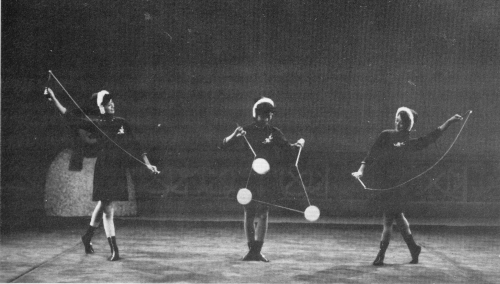|
The
next entertainer in the same show was a young lady named Jiang
Xiao Hong who
did cups and saucers on a tall unicycle. She stayed in place
for about four minutes using just one foot on the pedal. With
her other foot she kicked up sequentially four cups to her
head. Then she did two at once and finally three at once so
that a total of nine bowls balanced on her head.
After
tossing them down to an assistant, she kicked up one at a time
four cups and saucers. As a finale, she kicked up a cloth doll
into the top teacup, and in three tries landed a rubber-tipped
shuttlecock on top of the doll's head. Other world-class
troupes of Chinese acrobats that provide a home for juggling
can be found in
Beijing,
Chongqing, Nanking,
Shanghai, Tian Jin and
Wuhan.
When
most people think of juggling, they think of throwing and
catching such things as balls, rings or clubs with the hands.
Balls and rings remain popular juggling props in the People's
Republic today. Rings are also used for spinning tricks and
team juggling, as in the West. Similarly, fire torches are
used for added visual effect and things like hats and kitchen
utensils are used for more humorous routines. Badminton
rackets are frequently used as juggling props as well.
Surprisingly
enough, however, clubs as Westerners know them are almost
never juggled in a public show. Usually made of wood and
leather, and not especially appealing to the eye, clubs are
used primarily as a rehearsal or learning tool. They function
as a means towards handling
blades or objects that bring the elements of danger or humor
before the audience.
Another
unusual thing is that many jugglers practice and perform with
hollow,
rather light-weight rubber balls, like racquet balls, instead
of the lacrosse balls or similarly weighted objects often used
by western jugglers.
Because
China
is, in a technological sense, a "developing
country," it's not likely that you'll see a Chinese
juggler ply his art by juggling a chainsaw or a miniature
television or other trick involving high-tech props. However,
there are many Chinese jugglers today who perform with five,
six and seven balls and/or rings. There are also several
performers who manipulate five or six club-like objects. But
there have been few Chinese jugglers who have performed with
seven club-like objects or with more than seven balls or
rings. This is not surprising because it reflects a rather
similar level of performance ability with that known in the
western world.
What
is surprising, however, is that Chinese jugglers seem to have
spent little time pursuing numbers juggling even privately.
When this article was being researched, a variety of
administrators, coaches and performers from several Chinese
acrobatic troupes were shown pictures of Albert Lucas
(Jugglers World, Fall
1984). In one he is flashing ten balls, in the other twelve
rings. Their reactions were a mixture of disbelief, respect
and inspiration.
Most,
if not all, professional jugglers in the People's Republic of
China
have been schooled in basic tumbling and ballet. Many of the
respected Chinese jugglers are also capable of expert
performance in one or more other area of acrobatic art, like
wire-walking or magic. Of course many western jugglers are
multitalented as well. But if juggling ever develops
international competition.
Chinese
jugglers will be among the top competitors.
Besides the performances of the professionals who are part of
an acrobatic troupe,
some juggling is done by the citizenry of the People's
Republic of China. Although it is not enjoying a renaissance
equal to that in the
United States
or Europe, and it has no organization of
amateurs or local groups that meet regularly, at least one
basic move can be seen daily on the streets and in the parks
of any Chinese city. |

